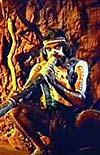Aboriginal Art
 Recognized as the world's oldest and longest continuous living tradition, aboriginal art forms part of the ancient Aboriginal culture. These ancient arts can be found all over Australia in the form of paintings or engravings on rocks. These paintings can be as old as 50,000 years old to over 110,000 years old. Prior to the 1970s, the public image of Aboriginal art was only restricted to painted utility and 'bark paintings'. Barks are strips of eucalyptus bark that have been flattened, dried, and smoothed prior to decoration with brown, white, yellow, black, and occasionally red natural pigments. While these were traditionally used for rituals, they have been widely produced for sale since the 1940s. Recognized as the world's oldest and longest continuous living tradition, aboriginal art forms part of the ancient Aboriginal culture. These ancient arts can be found all over Australia in the form of paintings or engravings on rocks. These paintings can be as old as 50,000 years old to over 110,000 years old. Prior to the 1970s, the public image of Aboriginal art was only restricted to painted utility and 'bark paintings'. Barks are strips of eucalyptus bark that have been flattened, dried, and smoothed prior to decoration with brown, white, yellow, black, and occasionally red natural pigments. While these were traditionally used for rituals, they have been widely produced for sale since the 1940s.
 The international explosion in Australian Aboriginal Art began in the early 1970s as a spark in Northern Territory with various groups in Arnhem Land and the desert community of Papunya, west of Alice Springs. In central Australia, Geoffrey Bardon introduced polymer paints to desert-dwellers, producing an entirely new genre of art. Hence, the strongly symbolic dot style was born. Today the National Gallery in Canberra, the state and private galleries in all major cities feature desert and Top End art. The international explosion in Australian Aboriginal Art began in the early 1970s as a spark in Northern Territory with various groups in Arnhem Land and the desert community of Papunya, west of Alice Springs. In central Australia, Geoffrey Bardon introduced polymer paints to desert-dwellers, producing an entirely new genre of art. Hence, the strongly symbolic dot style was born. Today the National Gallery in Canberra, the state and private galleries in all major cities feature desert and Top End art.
Arnhem Land and neighboring Kakadu National Park in Northern Territory provide the finest Aboriginal rock art experiences. At Ubirr shelter in Kakadu, many of the paintings were made well before the last Ice Age 8,000 years ago. Art of animal depictions, X-ray paintings of fishes, and sailing vessels document the arrival of European in Australia. Each painting tells a story of the colorful history of Australia.
Top of Page |
